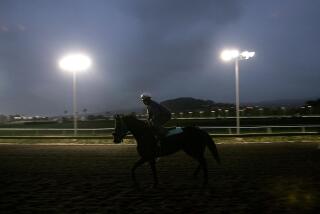Reno air races get new safeguards after last year’s fatal crash
A year after an accident at the National Championship Air Races in Reno killed 11 people and injured dozens more, officials have implemented changes that they hope will improve the safety of an event in which airplanes can reach speeds of more than 500 mph and fly as low as 50 feet above the ground.
The event has been under close scrutiny since a World War II-era P-51 Mustang flown by Jimmy Leeward, a 74-year-old Florida real estate developer, plunged into the crowd , killing himself and 10 spectators.
Pilots began qualifying for the event Monday morning in anticipation of the races that get underway Wednesday and run through Sunday at Reno-Stead Airport.
“Everybody went into this year with a bit of trepidation,” said Mike Houghton, chief executive of the Reno Air Racing Assn. “We looked at everything from different angles.”
After reviews by the Federal Aviation Administration and the National Transportation Safety Board, the association said it has implemented several new measures, including moving racing pylons 150 feet farther from grandstands, installing 4-foot-tall concrete barriers in front of grandstands, and easing some of the tighter turns on the oval course, which is nearly 8 1/2 miles long.
Houghton acknowledged the inherent risk of an event that is — in effect — an aerial NASCAR race.
“It’s racing,” he said. “So, yes, the risk is greater than zero.”
On Sept. 16, 2011, a P-51, named the Galloping Ghost, went out of control at 512 mph in the third lap of the six-lap race. The plane had undergone significant modifications, including having its wingspan reduced eight feet and its engine altered to make it faster.
According to a report by the NTSB, deteriorated locknut inserts allowed screws to become loose in the tail area. The plane shot skyward. The high speeds incapacitated the pilot. The plane rolled over and dived into the box seating area, showering spectators with debris.
Until that accident, crashes had killed 19 pilots but no spectators since the races began in 1964.
The NTSB found that undocumented and untested major modifications to the airplane contributed to the accident, “as well as the pilot’s operation of the airplane in the unique air racing environment without adequate flight testing.”
The board issued 10 safety recommendations, many of which were adopted by the Reno Air Racing Assn.
“It’s good news for the air races that so many of our recommendations have been addressed,” NTSB Chairman Deborah A. P. Hersman said in an Aug. 27 statement. “We will continue to push for the full implementation of all of our safety recommendations.”
This year, the event is expected to draw 140 racers and 200,000 spectators.
It is a tall order to ensure their safety. But the job falls to Michael Stollings, a former Boeing Co. engineer, who this year was named the air races’ first director of safety.
Stollings said the association that famously urges pilots “Always remember to fly low, fly fast and turn left!” is going through somewhat of a “culture change” with the new precautions.
“We can’t make it 100% safe,” he said. “But we’re doing the best we can.”
The FAA said it performed a top-to-bottom review of operations before this year’s event.
“Safety is FAA’s top priority,” the FAA said in a statement. “The agency continues to work closely with air race organizations and conduct thorough inspections to ensure compliance with FAA safety regulations.”
Under FAA rules, air shows and races must keep spectators at least 500 feet away from planes flying normally and 1,500 feet away from those performing maneuvers involving sharp turns or steep climbs.
Michael Barr, an accident investigation expert at USC and former combat pilot, said there is no real way to ensure crowd safety.
This year, the association saw its insurance premium for the race soar by $1.7 million.
“I suppose you could have the planes racing in a straight line and have the crowd sit a mile away,” Barr said. “But who would pay to see that?”
More to Read
Inside the business of entertainment
The Wide Shot brings you news, analysis and insights on everything from streaming wars to production — and what it all means for the future.
You may occasionally receive promotional content from the Los Angeles Times.











